If you have decayed or damaged teeth dental restoration can help you regain a healthy smile. These procedures not only enhance the appearance of teeth but also improve the overall health of teeth. There are two main types of dental restorations: direct, which can be done in a single visit, and indirect, which are custom-made for your teeth.
Different types of restoration materials are used in these procedures including metals, porcelain, PFM, and zirconia. Among the most sought-after materials zirconia is a popular choice. It is used in the manufacturing of zirconia dental crowns, veneers, bridges, inlays, onlays, and dental implants. This article provides comprehensive information on zirconia restoration and why it might be the perfect solution for you.
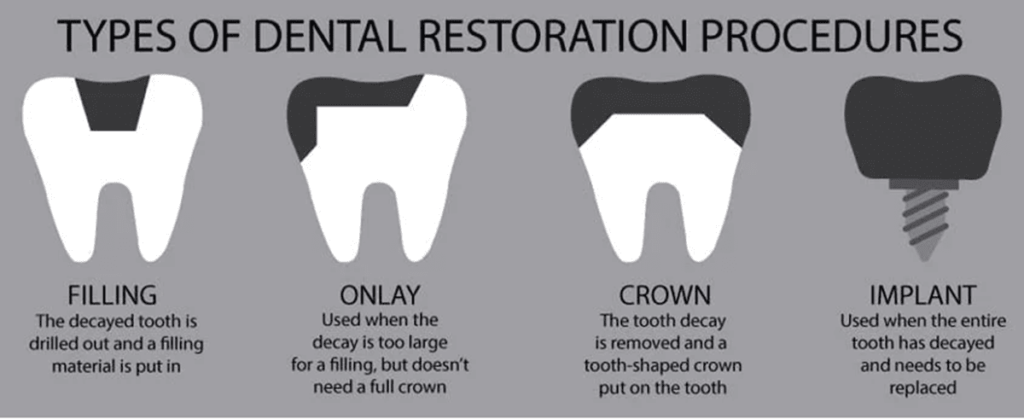
What is Zirconia Restoration?
Zirconia is a ceramic material that exhibits exceptional strength. In modern dentistry, zirconia provides a natural appearance and resistance to wear. If you are looking for long-lasting, functional, and attractive dental solutions zirconia restorations are an excellent choice for you. Its properties like biocompatibility, translucency, and durability make it an ideal choice for dental restorations.
Types of Zirconia Restoration
Zirconia restoration types include dental crowns, bridges, veneers, inlays, dental implants, and onlays. From repairing minor damage to replacing missing teeth these options provide versatile solutions. Based on your teeth condition and preferences your dentist may recommend the most effective treatment for you. Let’s take a look at the details of zirconia restoration types.
Zirconia Restoration Crowns
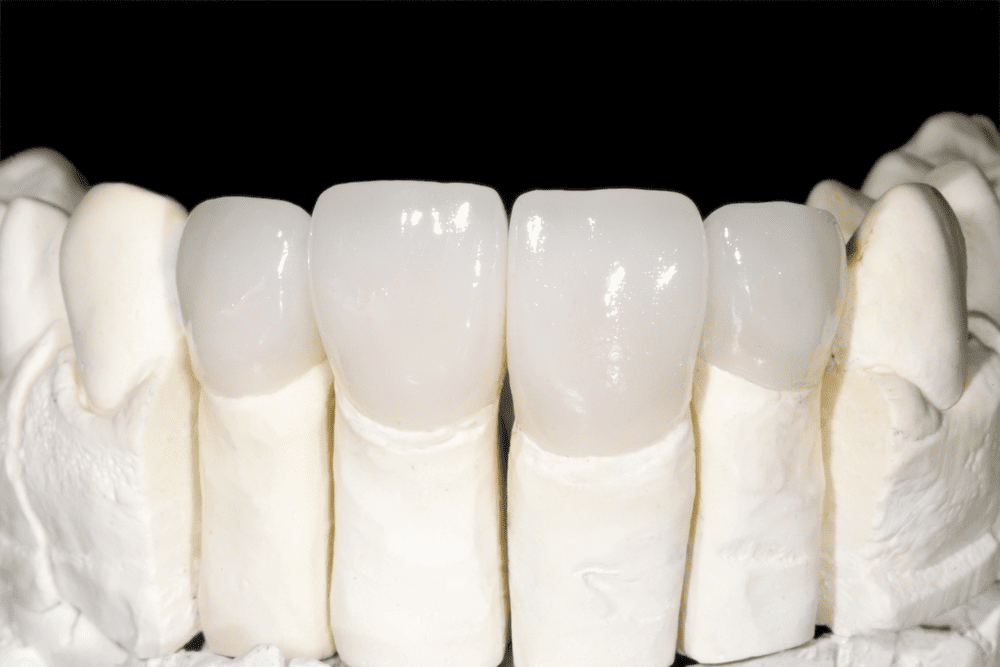
You can think of a dental crown as a custom-made cap to cover teeth. Crowns cover damaged, weakened, or misshapen teeth. They restore the tooth’s shape, size, strength, and appearance while also protecting it from further damage. Zirconia crown restoration involves fitting a zirconia crown over the tooth. Zirconia crowns are ideal for both front and back teeth.
These crowns provide high strength that can withstand strong chewing forces. Additionally, these crowns seamlessly integrate into natural teeth.
Zirconia Restoration Veneers
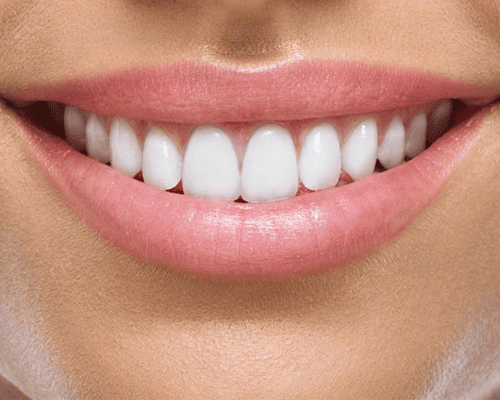
If you want a straighter and polished smile without braces veneers are an excellent option. Veneers are thin, custom-made shells designed to cover the front surface of teeth, instantly transforming their appearance. Zirconia restoration veneers are made with ceramic material zirconium oxide. Compared to other materials like porcelain, zirconia veneers are less prone to staining which makes them ideal for long-term use. If durability and a natural look are what you’re after, zirconia veneers might be the perfect choice for you.
Zirconia Restoration Bridges
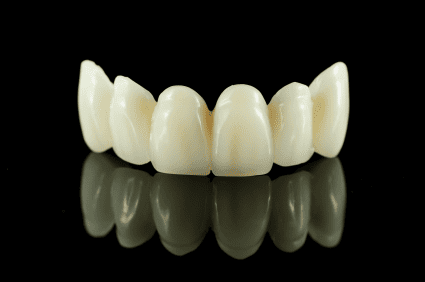
Missing teeth can cause problems in chewing and speaking. It can also lower your confidence significantly. As the name implies dental bridges “bridge the gap” between your teeth. A dental bridge consists of a false tooth and two crowns which are fitted over the adjacent teeth.
In the past, metals were used to make false teeth but they lack aesthetic appeal. The Zirconia dental bridge not only gives durability but also looks pleasing.
Fixed zirconia bridge provides a permanent solution for tooth loss. This type of zirconia restoration cannot be removed by the patient.
Zirconia Restoration Inlays and Onlays
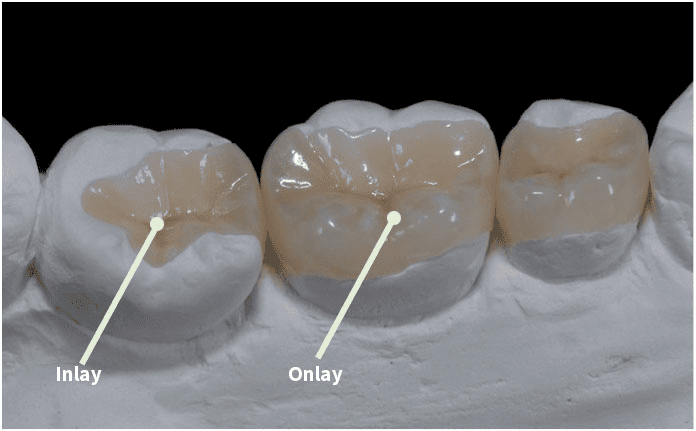
Zirconia inlays and onlays restoration are treatments for cavities. The basic difference between inlays and onlays is the area they cover. Inlay zirconia restoration is typically used for cavities that don’t affect the tooth’s outer structure. It fills the cavity without covering the pointed edges of the tooth. While onlay is an extensive restoration. It is typically used when a larger portion of the tooth is damaged but not enough to require a full crown.
Zirconia Restoration Implant
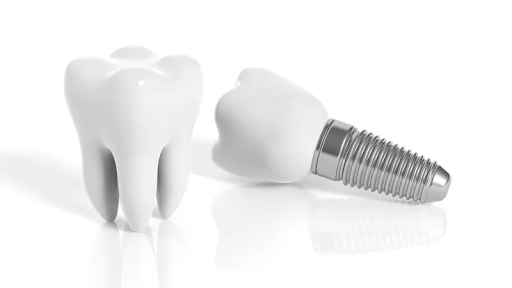
A dental implant is a surgical tooth replacement procedure. In this procedure dental will insert a screw-like structure in the jaw bone that acts as a replacement for the missing tooth. Zirconia-based dental implants offer metal-free restoration for patients who do not prefer metal. For patients with complete tooth loss or severely decayed teeth full arch zirconia restoration is a good choice. A full-arch zirconia restoration is a dental solution that replaces all the teeth in an upper or lower arch with a single, durable prosthetic made entirely of zirconia.
Pros of Zirconia Restoration
The reason why zirconia restorations are preferred over other restorations lies in their unmatched properties. Zirconia restorations have several advantages which are discussed below:
- Strength: Dental restoration should be strong enough to withstand strong chewing forces, especially in posterior areas. If the material used in restoration is not strong enough it will crack. Out of all materials zirconia restorations provide unmatched strength.
- Durability: Certain conditions in the mouth like saliva, pH, and food can cause corrosion in dental restoration. Zirconia restoration is durable and these factors do not impact its performance. With proper oral it can last up to 20 years.
- Biocompatibility: Zirconia restorations are fully biocompatible. They do not trigger an immune response in the body and do not irritate surrounding tissues.
- Minimal wear on opposing teeth: Some materials like metals are abrasive to natural teeth and cause unnecessary wear. On the contrary, zirconia restorations are gentle and do not cause damage to the teeth that come in contact with them during biting or chewing.
Cons of Zirconia Restoration
While considering zirconia restoration you should also consider some downsides of zirconia. Following are some cons of zirconia restoration.
- Less Translucency: Front teeth have a see-through appearance and zirconia lacks this property. For a more natural appearance materials like porcelain are preferred.
- Cost: Zirconia restorations can be more expensive than other materials like composite or porcelain-fused-to-metal.
How to Choose the Right Zirconia Material
Low-quality zirconia material will have a low upfront cost. But you’ll have to compromise on quality. While choosing Zirconia Material ensure it has following properties:
1. It has high strength for load-bearing areas.
2. Choose zirconia that is easy to mill, with minimal risk of chipping.
3. Ensure zirconia block comes in multiple shades or can be stained to match adjacent teeth.
Opt for zirconia from reputable manufacturers with a track record of quality and innovation. Aidite is known for its Zirconia Material prepared with cutting-edge technology. Our wide range of products is tailored to meet the specific needs of various dental restorations.
FAQs Related to Zirconia Restoration
What is Monolithic zirconia restoration?
Monolithic zirconia restoration is made from solid blocks of zirconia. Monolithic crowns and bridges are made of a single, unbroken block of zirconia. This type of zirconia restoration is highly durable and resistant to fractures or chipping.
What are Zirconia restoration types properties?
Different types of zirconia restorations including crowns, bridges, veneers, etc share a few common advantages, such as durability, resistance to staining, and biocompatibility.
What are the types of restorations in dentistry?
The main types of dental restorations include fillings, crowns, veneers, bridges, inlays and onlays, dental implants, and full-arch zirconia restorations. Different types of restorations are used to treat different teeth conditions. Your dentist may recommend a solution after examining the condition of your teeth.
What are zirconia-based ceramic restorations?
Zirconia-based ceramic restorations are dental restorations made from zirconium dioxide. Zirconium dioxide is a strong and biocompatible ceramic material. Its ability to mimic the natural appearance of teeth and resistance to wear makes it an ideal material for various dental restoration materials.
Conclusion
In conclusion, from minor repairs to full tooth replacement zirconia restorations are a reliable option. They are strong, durable, and closely mimic the natural appearance of teeth. From crowns to implants, zirconia offers practical solutions for restoring function and appearance. Each dental case is different, but zirconia’s versatility makes it suitable for many patients. Whether you need a crown, bridge, or implant, zirconia provides consistent results that patients and dentists value.
Regarding zirconia restorations, the quality of the material plays a crucial role in the final result. That’s where Aidite stands out. As a pioneer in oral digitalization, Aidite offers dental materials that are durable, precise, and natural-looking. Since 2016, Aidite has been providing a comprehensive chairside digital solution with advanced materials, equipment, training, and support.



